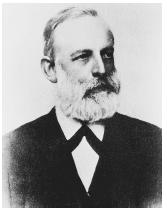Lothar Meyer
GERMAN CHEMIST 1830–1895
Lothar Meyer was the son and grandson of physicians, so it was only natural that initially he decided on a career as a physician. At the age of twenty-one, he began his studies in medicine at the University of Zurich and received his M.D. in 1854. By then Meyer had become interested in the chemistry of the body and went on to study under Robert Bunsen at Heidelberg, where he learned how to analyze gases. He used these techniques to study the absorption of oxygen and carbon monoxide by the blood, and was able to establish that they both reacted in a similar fashion with the same constituent present in the blood. Meyer also determined that carbon monoxide was able to displace oxygen from the blood. However, he was unable to identify the particular component in the blood responsible for binding. This substance was identified as hemoglobin eight years later by Felix Hoppe-Seyler, a professor of physiological chemistry at the University of Strasbourg in France. For this work, Meyer received his Ph.D. in 1858 at the University of Breslau, and he became the director of the chemical laboratory in the physiology institute there until 1866.

In 1864 Meyer published Modern Theories of Chemistry, which went through five editions and was translated into English, French, and Russian. This book contained a prototype of his 1870 Periodic Table, which consisted of only twenty-eight elements arranged in six families that had similar chemical and physical characteristics. Above all he used a number referred to as the combining power of each element, later termed the valence , to link together a particular family. For example, carbon, silicon, tin, and lead were assigned to the same family because each exhibited a combining power of four. He also recognized the following from the observation that atomic weights usually increase by a certain amount between family members: A missing element existed between silicon and tin (later this gap was filled by germanium, discovered in 1886 by the German chemist Clemens Winkler). By 1868 he had expanded his table to include fifty-three elements, but this version was not made public until 1895. This was unfortunate because in 1869 the Russian chemist Dimitri Mendeleev published his version of the Periodic Table in a paper entitled, "The Relation of the Properties to the Atomic Weights of the Elements." As well as postulating his table, Mendeleev described how it could be used to predict not only the atomic weight of missing elements, but also their actual properties.
The most famous of Mendeleev's predictions involved eka-boron (scandium), eka-aluminium (gallium), and eka-silicon (germanium). For example, for eka-silicon he predicted its atomic weight, its density, the compounds it would form, and details about their physical properties. When thirteen years later germanium was discovered and it was determined that Mendeleev's predictions had been correct, scientists began to recognize the importance of the Periodic Table, and its discovery was quite naturally associated with Mendeleev, who encouraged this association.
Even in the twenty-first century, although historians recognize that others, especially Meyer, should be given considerable credit for the discovery of the periodic properties of the elements, most textbooks credit only Mendeleev.
SEE ALSO Bunsen, Robert ; Mendeleev, Dimitri ; Periodic Table .
John E. Bloor
Bibliography
Van Spronsen, Johannes W. (1969). "The Priority Conflict between Mendeleev and Meyer." Journal of Chemical Education 46:136–139.
Internet Resources
Beavon, Rod. Translation of part of Meyer's 1870 paper on the Periodic Table. Available from http://www.rod.beavon.clara.net/lotharme.htm .